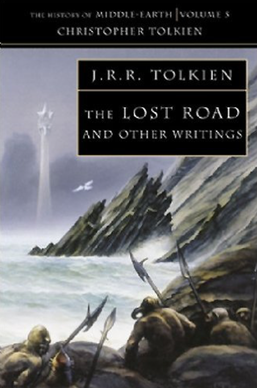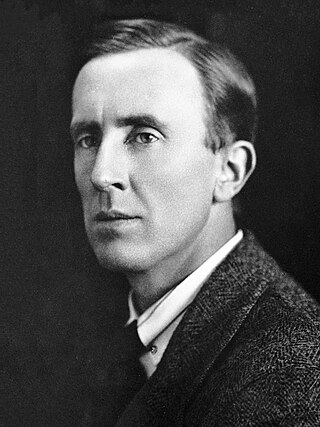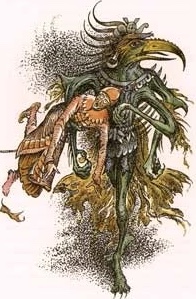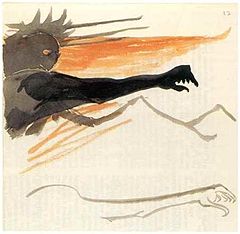The Ainulindalë is the creation account in J. R. R. Tolkien's legendarium, published posthumously as the first part of The Silmarillion in 1977. The "Ainulindalë" sets out a central part of the cosmology of Tolkien's legendarium, telling how the Ainur, a class of angelic beings, perform a great music prefiguring the creation of the material universe, Eä, including Middle-Earth. The creator Eru Ilúvatar introduces the theme of the sentient races of Elves and Men, not anticipated by the Ainur, and gives physical being to the prefigured universe. Some of the Ainur decide to enter the physical world to prepare for their arrival, becoming the Valar and Maiar.

The Lost Road and Other Writings – Language and Legend before 'The Lord of the Rings' is the fifth volume of The History of Middle-earth, a series of compilations of drafts and essays written by J. R. R. Tolkien in around 1936–1937. It was edited and published posthumously in 1987 by Christopher Tolkien.

The Round World Version is an alternative creation myth to the canonical version of J.R.R. Tolkien's legendarium as it appears in The Silmarillion and The Lord of the Rings. In the canonical version, the Earth was created flat and was changed to round as a cataclysmic event during the Second Age in order to prevent direct access by Men to Valinor, home of the immortals. In the Round World Version, the Earth is created spherical from the beginning.

In J. R. R. Tolkien's legendarium, the history of Arda, also called the history of Middle-earth, began when the Ainur entered Arda, following the creation events in the Ainulindalë and long ages of labour throughout Eä, the fictional universe. Time from that point was measured using Valian Years, though the subsequent history of Arda was divided into three time periods using different years, known as the Years of the Lamps, the Years of the Trees and the Years of the Sun. A separate, overlapping chronology divides the history into 'Ages of the Children of Ilúvatar'. The first such Age began with the Awakening of the Elves during the Years of the Trees and continued for the first six centuries of the Years of the Sun. All the subsequent Ages took place during the Years of the Sun. Most Middle-earth stories take place in the first three Ages of the Children of Ilúvatar.

Tash is a fictional deity and demonic god, found in C. S. Lewis's Chronicles of Narnia series. He is an antagonist in the novels The Horse and His Boy and The Last Battle.
The cosmology of J. R. R. Tolkien's legendarium combines aspects of Christian theology and metaphysics with pre-modern cosmological concepts in the flat Earth paradigm, along with the modern spherical Earth view of the Solar System.
The Ainur (singular: Ainu) are the immortal spirits existing before the Creation in J. R. R. Tolkien's fictional universe. These were the first beings made of the thought of Eru Ilúvatar. They were able to sing such beautiful music that the world was created from it.
The Maiar are a fictional class of beings from J. R. R. Tolkien's high fantasy legendarium. Supernatural and angelic, they are "lesser Ainur" who entered the cosmos of Eä in the beginning of time. The name Maiar is in the Quenya tongue from the Elvish root maya- "excellent, admirable".

Middle-earth is the setting of much of the English writer J. R. R. Tolkien's fantasy. The term is equivalent to the Miðgarðr of Norse mythology and Middangeard in Old English works, including Beowulf. Middle-earth is the human-inhabited world, that is, the central continent of the Earth, in Tolkien's imagined mythological past. Tolkien's most widely read works, The Hobbit and The Lord of the Rings, are set entirely in Middle-earth. "Middle-earth" has also become a short-hand term for Tolkien's legendarium, his large body of fantasy writings, and for the entirety of his fictional world.
Morgoth Bauglir is a character, one of the godlike Valar, from Tolkien's legendarium. He is the main antagonist of The Silmarillion, The Children of Húrin, Beren and Lúthien, and The Fall of Gondolin.

Sauron is the title character and the primary antagonist, through the forging of the One Ring, of J. R. R. Tolkien's The Lord of the Rings, where he rules the land of Mordor and has the ambition of ruling the whole of Middle-earth. In the same work, he is identified as the "Necromancer" of Tolkien's earlier novel The Hobbit. The Silmarillion describes him as the chief lieutenant of the first Dark Lord, Morgoth. Tolkien noted that the Ainur, the "angelic" powers of his constructed myth, "were capable of many degrees of error and failing", but by far the worst was "the absolute Satanic rebellion and evil of Morgoth and his satellite Sauron". Sauron appears most often as "the Eye", as if disembodied.
The Valar are characters in J. R. R. Tolkien's legendarium. They are "angelic powers" or "gods" subordinate to the one God. The Ainulindalë describes how those of the Ainur who choose to enter the World (Arda) to complete its material development after its form is determined by the Music of the Ainur are called the Valar, or "the Powers of the World". The Valaquenta indicates that the Elves generally reserve the term "Valar" for the mightiest of these, calling the others the Maiar.

The Silmarillion is a collection of myths and stories in varying styles by the English writer J. R. R. Tolkien. It was edited and published posthumously by his son Christopher Tolkien in 1977, assisted by the fantasy author Guy Gavriel Kay. It tells of Eä, a fictional universe that includes the Blessed Realm of Valinor, the once-great region of Beleriand, the sunken island of Númenor, and the continent of Middle-earth, where Tolkien's most popular works—The Hobbit and The Lord of the Rings—are set. After the success of The Hobbit, Tolkien's publisher Stanley Unwin requested a sequel, and Tolkien offered a draft of the writings that would later become The Silmarillion. Unwin rejected this proposal, calling the draft obscure and "too Celtic", so Tolkien began working on a new story that eventually became The Lord of the Rings.
The Chronicles of Narnia is a series of seven fantasy novels for children written by C. S. Lewis. It is considered a classic of children's literature and is the author's best-known work, having sold over 100 million copies in 47 languages. In addition to numerous traditional Christian themes, the series borrows characters and ideas from Greek and Roman mythology, and from British and Irish folklore.
Christianity is a central theme in J. R. R. Tolkien's fictional works about Middle-earth, but always a hidden one. This allows the book to be read at different levels, and its meaning to be applied by the reader, rather than forcing a single meaning on the reader.
Tolkien's monsters are the evil beings, such as Orcs, Trolls, and giant spiders, who oppose and sometimes fight the protagonists in J. R. R. Tolkien's Middle-earth legendarium. Tolkien was an expert on Old English, especially Beowulf, and several of his monsters share aspects of the Beowulf monsters; his Trolls have been likened to Grendel, the Orcs' name harks back to the poem's orcneas, and the dragon Smaug has multiple attributes of the Beowulf dragon. The European medieval tradition of monsters makes them either humanoid but distorted, or like wild beasts, but very large and malevolent; Tolkien follows both traditions, with monsters like Orcs of the first kind and Wargs of the second. Some scholars add Tolkien's immensely powerful Dark Lords Morgoth and Sauron to the list, as monstrous enemies in spirit as well as in body. Scholars have noted that the monsters' evil nature reflects Tolkien's Roman Catholicism, a religion which has a clear conception of good and evil.

The music of Middle-earth consists of the music mentioned by J. R. R. Tolkien in his Middle-earth books, the music written by other artists to accompany performances of his work, whether individual songs or adaptations of his books for theatre, film, radio, and games, and music more generally inspired by his books.







